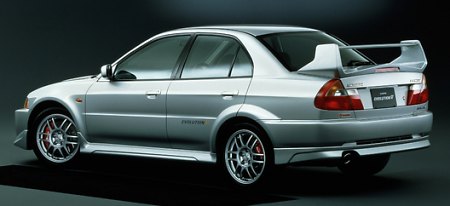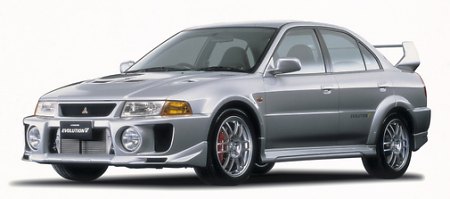- The interior was upgraded in the GSR version with a better class of Recaro seat.
- The body kit had flared arches at the front and rear and a new aluminium rear spoiler replaced the IV FRP version and gave an adjustable angle of attack to alter rear down force.
- The track was widened by 10 mm (0.4 in), the wheel offset changed from ET45 to ET38 along with the wheel diameter which rose from 16" to 17" to accommodate Brembo brakes which were added to enhance braking.
- In addition the brake master cylinder bore increased by 0.3 millimetres (0.01 in).
- The engine was strengthened in a few areas and the cam duration was increased. The pistons were lighter with a smaller skirt area. 510 cc injectors were replaced with 560 cc injectors for better engine reliability due to more electrical "headroom" and the ECU was changed to include a flash ROM, allowing more boost pressure to the same TD05-HR as the Mitsubishi Evolution IV.
| Fifth Generation | |
|---|---|
| Overview | |
| Production | January 1998 - January 1999 |
| Body and chassis | |
| Platform | CP9A |
| Powertrain | |
| Transmission | 5-speed manual |
| Dimensions | |
| Wheelbase | 2,510 mm (98.8 in) |
| Length | 4,350 mm (171.3 in) |
| Width | 1,770 mm (69.7 in) |
| Height | 1,405–1,415 mm (55.3–55.7 in) |
| Curb weight | 1,260–1,360 kg (2,778–2,998 lb) |
Furthermore, the turbocharger was again improved. Torque was increased to 373 N·m (275 lb·ft) at 3000 rpm. Power officially stayed the same, at 280 PS (206 kW; 276 hp), though some claim horsepower was actually somewhat higher.
Debuted in Jan 1998, the Evo V was another big improvement. Its flared wheel arches accommodated wider tracks (up 40 and 35 mm front and rear, respectively) and larger 17-inch wheels shod with wider 225/45 tires. The suspension received optimized geometry, lightweight aluminum control arms and inverted dampers that lifted chassis rigidity. New brakes incorporated high-performance Brembo calipers. The AYC was further refined to reduce the understeer found on the previous generation. The new rear wing got an adjustable foil to alter downforce setting. All these significantly improved its handling.

Meanwhile, the engine got a new turbocharger and improved intercooler, lifting maximum torque from 261 to 275 lbft. While peak power was still quoted at 280 hp, or the upper limit agreed by Japanese manufacturers, the actual figure was undoubtedly higher. Road test found the Evo V was capable of 0-60 and 0-100 mph in 4.7 and 12.3 seconds, respectively. That put it ahead of many expensive performance cars of the day, including BMW M3 E36, Skyline GT-R R33, Mitsubishi's own flagship GTO and even Honda NSX. When the road got rougher and twistier, the Evo was even probably the fastest car in the world. Only the contemporary Subaru Impreza WRX STi Version IV could rival it.

No comments:
Post a Comment